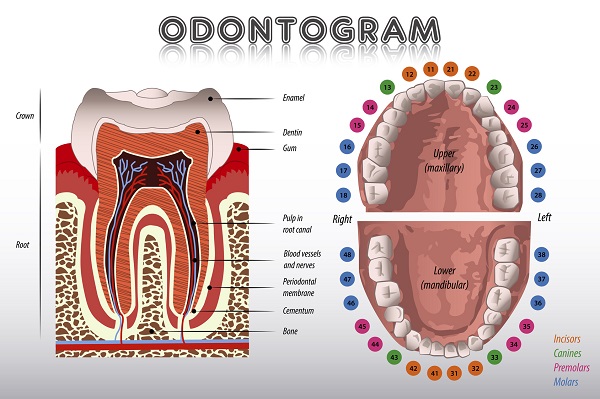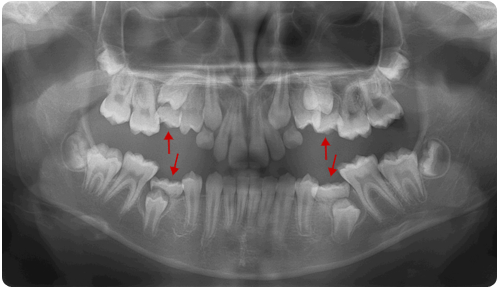Ankylosed teeth are encountered in children, adolescent, and adult patients. Both baby and permanent teeth can be ankylosed. This rare dental condition is associated with an unusual fusion (ankylosis) of the tooth to the bone. An ankylosed tooth is thus stuck to the bone, and cannot emerge. Left untreated, ankylosis of teeth can lead to further orthodontic problems, like crowding of teeth, or improper jaw growth. While the name of the condition may be intimidating, the good news is that it is treatable. Read on to learn exactly what an ankylosed tooth is, what causes it, and what can be done about it.
What Is Ankylosis Of Teeth?
An ankylosed tooth is one that is showing signs of dental ankylosis, a type of rare dental deformity. To understand exactly what it is, you must first know a bit about the parts of a healthy, normal tooth:
- The root. Shaped like one or two long branches, the root extends from the bottom of our tooth and is what holds it in place.
- The gum. This soft tissue surrounds your teeth, and is the pink stuff that you see when you look in your mouth.
- The periodontal membrane. This band of tissue lies between the gum and the tooth. It is made up of fibers that work like a sling to keep your tooth positioned.
- The jaw bone. This hard part of your skull is what lies underneath the gum tissue. It is what gives your jaws strength.

With an ankylosed tooth, a bridge of bone or a part of the tooth known as a cementum grows in between the root and your bone, through the gum tissue and the periodontal membrane. While both baby teeth and permanent teeth can become ankylosed teeth, the problem is most common with baby teeth. Children are more likely to be diagnosed with dental ankylosis as a result.
Tooth Ankylosis Causes
Typically, dental ankylosis happens when a baby tooth or permanent tooth does not emerge from the gum line properly. Because of this, bone or root tissue is able to build up and form a cementum. A number of things may cause the problem, including:
- An infection in your tooth, gums, or jaw.
- Abnormal jaw bone growth.
- Abnormalities of the mouth that make the tongue rest against the tooth.
- Heredity, so if someone in your family has ankylosed teeth, you are more likely to have it.
Why Does Ankylosis of Teeth Need to Be Treated?
An ankylosed tooth is not life-threatening, but it can cause serious dental problems. When a baby tooth becomes ankylosed, the permanent tooth cannot break through and push out the temporary tooth. As a result, the tooth will press on other teeth, leading to crookedness and crowding.
If a permanent tooth is ankylosed, it may be in an abnormal position that may cause pain, pressure, or difficulty chewing. Its position can lead to excessive wear and tear on other teeth and cause misalignments.
How Are Ankylosed Teeth Diagnosed?
Normally, dentists spot signs of dental ankylosis during regular checkups. Just looking at a tooth’s position can tell a dentist that teeth are likely to be ankylosed. Tapping on them with dental instruments can help confirm the suspicions.
Dental X-rays may be taken to assess the severity of the problem and see how other teeth are being impacted by the ankylosed tooth.
Ankylosed Tooth Treatment
If permanent teeth are ankylosed, your dentist is likely to simply monitor the problem and wait to see if it causes you any problems over time. Depending on the severity of the problem and the location of permanent ankylosed teeth, no treatment may be necessary.
For baby teeth that are ankylosed, treatment is crucial to ensure proper dental development. In most cases, the treatment for dental ankylosis is the surgical removal of the affected tooth. Normally, this type of surgery is done in the office of an oral surgeon, either with full anesthesia or a twilight sedative.
If the teeth located beside ankylosed teeth are baby teeth as well, they may also need to be removed in some cases. This is most likely to be necessary when an ankylosed baby tooth is a molar.
When a permanent ankylosed tooth requires treatment, oral surgery is usually performed to remove the tooth. A dental bridge or a dental implant may be used to replace the missing tooth, depending on its position.
Conclusion
Now that you know the answer to what is ankylosis of teeth, you can work with your dentist to develop a treatment plan for you or your child. Your dental provider can advise you what is the best treatment in your particular case. Have you ever had an ankylosed tooth? What treatment did you follow? Share your experience and thoughts with us!


Leave a Comment